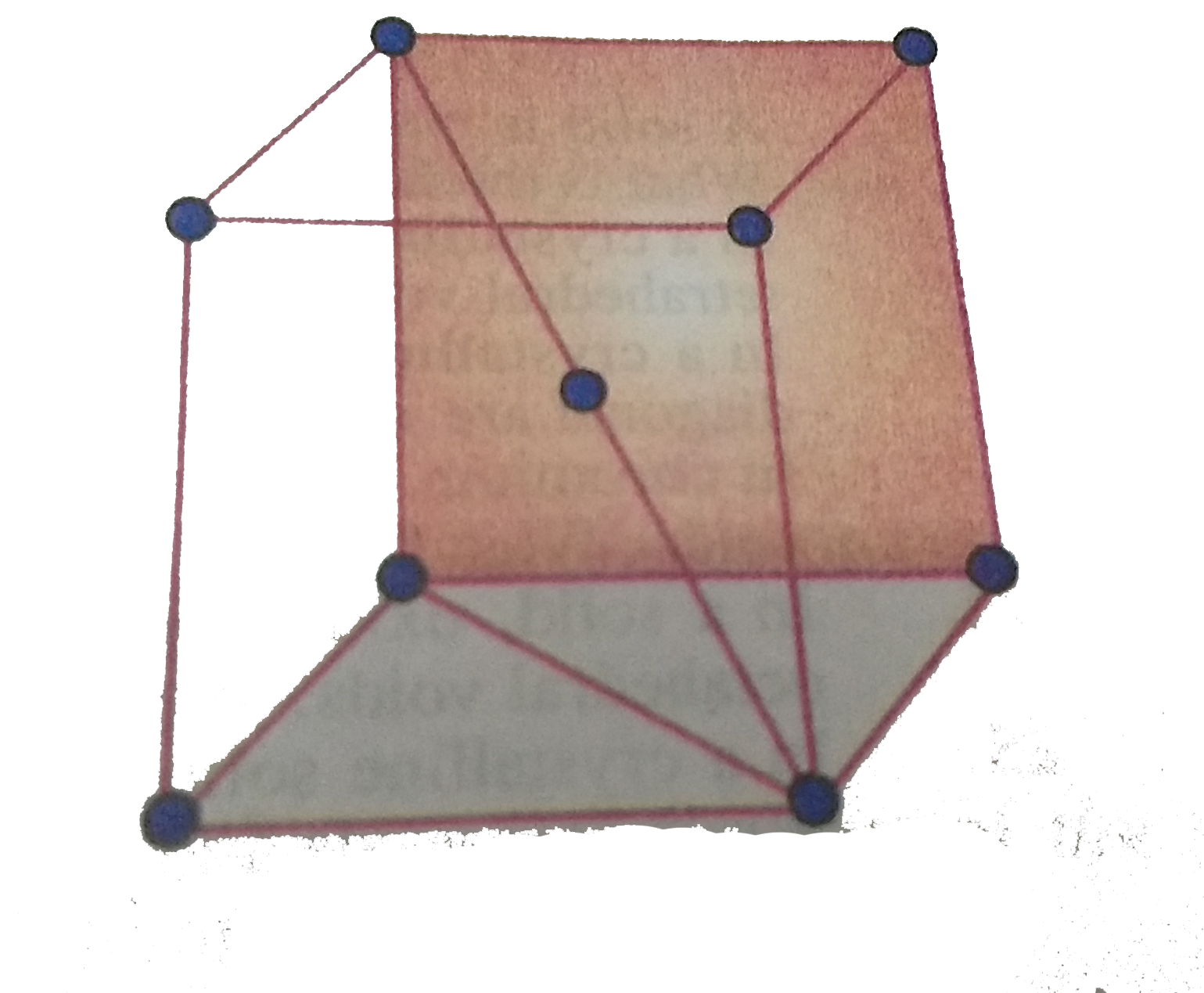How many "nearst" and "next nearst" neighbours, respectively, does potassium have in bcc lattice?
8,8
8,6
6,8
6,6
The correct Answer is:B
To determine the number of nearest and next nearest neighbors for potassium in a body-centered cubic (BCC) lattice, we can follow these steps:
1. Understanding the BCC Structure:
- In a BCC lattice, atoms are located at the eight corners of a cube and one atom is located at the center of the cube (body center).
2. Identifying Nearest Neighbors:
- For an atom located at a corner of the BCC unit cell, the nearest neighbors are the atoms that are closest to it.
- Each corner atom has one body-centered atom as its nearest neighbor.
- Additionally, there are 7 other corner atoms from adjacent unit cells that are also nearest neighbors.
- Therefore, the total number of nearest neighbors for a corner atom in a BCC lattice is:
Nearest neighbors=1 (body center)+7 (corner atoms from adjacent cells)=8
3. Identifying Next Nearest Neighbors:
- Next nearest neighbors are the atoms that are one step further away than the nearest neighbors.
- For the corner atom, the next nearest neighbors are the corner atoms that are directly adjacent in the same unit cell and in the adjacent unit cells.
- There are 3 corner atoms in the same unit cell and 3 corner atoms in the adjacent unit cells that are next nearest neighbors.
- Therefore, the total number of next nearest neighbors is:
Next nearest neighbors=3 (same unit cell)+3 (adjacent unit cells)=6
4. Final Answer:
- Thus, the number of nearest neighbors is 8 and the number of next nearest neighbors is 6.
Conclusion:
The number of nearest neighbors for potassium in a BCC lattice is 8, and the number of next nearest neighbors is 6.
---
- In a BCC lattice, atoms are located at the eight corners of a cube and one atom is located at the center of the cube (body center).
- For an atom located at a corner of the BCC unit cell, the nearest neighbors are the atoms that are closest to it.
- Each corner atom has one body-centered atom as its nearest neighbor.
- Additionally, there are 7 other corner atoms from adjacent unit cells that are also nearest neighbors.
- Therefore, the total number of nearest neighbors for a corner atom in a BCC lattice is:
Nearest neighbors=1 (body center)+7 (corner atoms from adjacent cells)=8
- Next nearest neighbors are the atoms that are one step further away than the nearest neighbors.
- For the corner atom, the next nearest neighbors are the corner atoms that are directly adjacent in the same unit cell and in the adjacent unit cells.
- There are 3 corner atoms in the same unit cell and 3 corner atoms in the adjacent unit cells that are next nearest neighbors.
- Therefore, the total number of next nearest neighbors is:
Next nearest neighbors=3 (same unit cell)+3 (adjacent unit cells)=6
- Thus, the number of nearest neighbors is 8 and the number of next nearest neighbors is 6.
The number of nearest neighbors for potassium in a BCC lattice is 8, and the number of next nearest neighbors is 6.
Topper's Solved these Questions
- SOLID STATEBOOK - NARENDRA AWASTHI ENGLISHCHAPTER - SOLID STATEEXERCISE - Level-2
32 Videos
- SOLID STATEBOOK - NARENDRA AWASTHI ENGLISHCHAPTER - SOLID STATEEXERCISE - Level 3 passage -1
1 Videos
- IONIC EEQUILIBRIUMBOOK - NARENDRA AWASTHI ENGLISHCHAPTER - IONIC EEQUILIBRIUMEXERCISE - Subjective problems
1 Videos
- STOICHIOMETRYBOOK - NARENDRA AWASTHI ENGLISHCHAPTER - STOICHIOMETRYEXERCISE - Match the Colum-II
6 Videos
Similar Questions
How many 'nearest' and ' next nearest' neighbours respectively does potassium have in s.c. lattice
View SolutionHow many 'nearest' and 'next nearest' neighbours respectively does sodium have in f.c.c. lattice
View SolutionPotassium crystallises in a bcc lattice as shown in figure :
(a) What is the distance the nearest neighbours ?
(b) What is the distance between the next nearest neighbours ?
(c) How many nearest neighbours does each potassium atom have ?
(d) How many next nearest neighbours does each potassium atom have ?

View SolutionPotassium crystallizes in body centered cubic lattice with a unit cell length a=5.2Å
(A) what is the distance betweenn nearest neighbourss?
(B) What is the distance between next nearest neighbour ?
(C) How many nearest neighbours does each K atom have ?
(D) How many next nearest neighbours does each K has ?
(E) What is calculated density of crystalline K
View SolutionHow many end points does a line have?
View SolutionHow many end points does a ray have ?
View SolutionAn element crystallises in a b.c.c. lattice. Nearest and next nearest neighbours are respectively
View SolutionThe numberof next nearest neighbours of Cs+ in a lattice of CsCl is given by:
View SolutionHow many nearest neighbours surround each ion in a face-centered cubic lattice of an ionic crystal ?
View SolutionHow many Cs+ ions occupy the second nearest neighbour location of a Cs+ ion in the structure CsCl (8:8 coordination ) ?
View Solution
